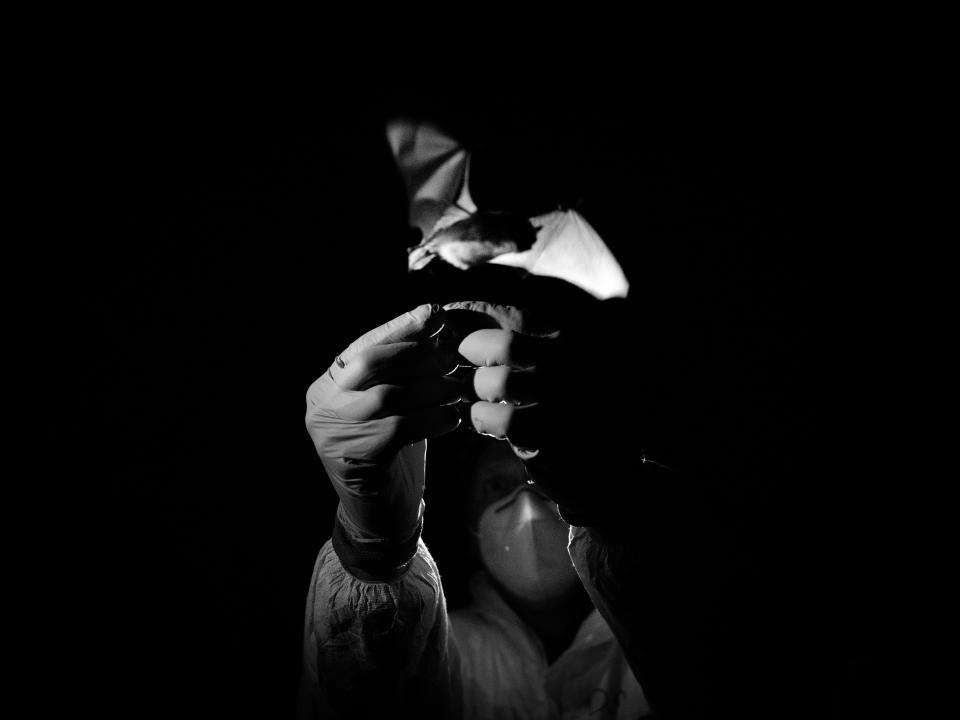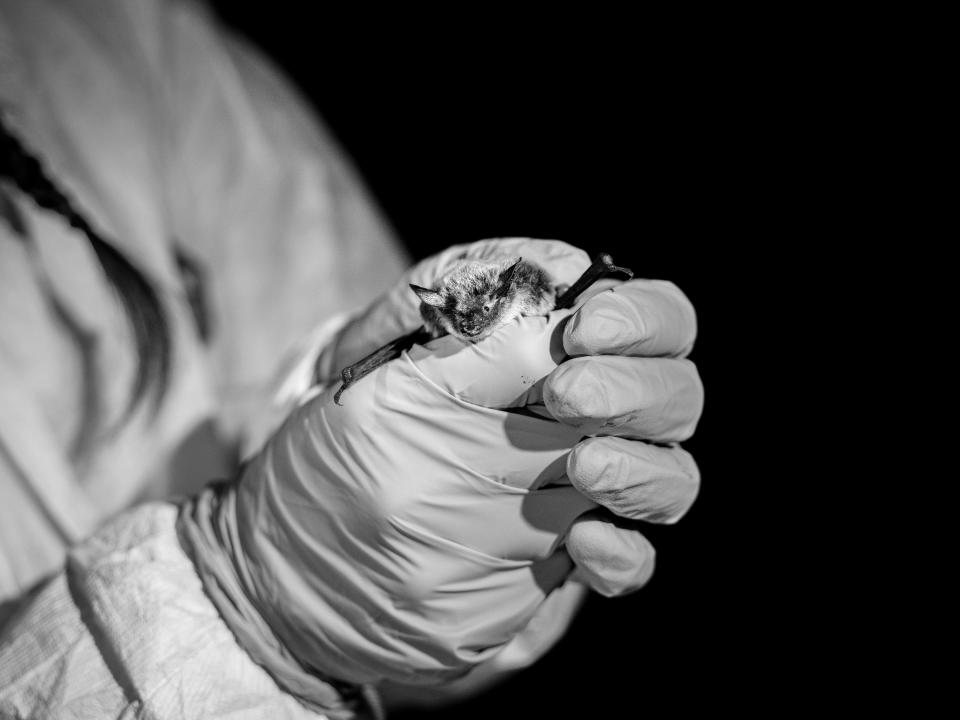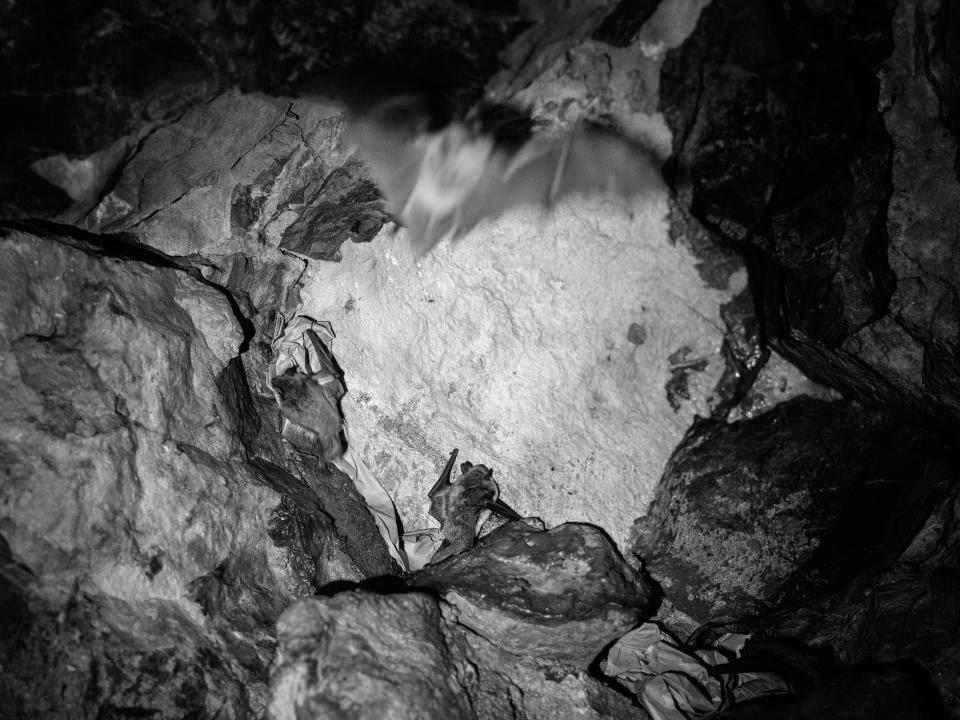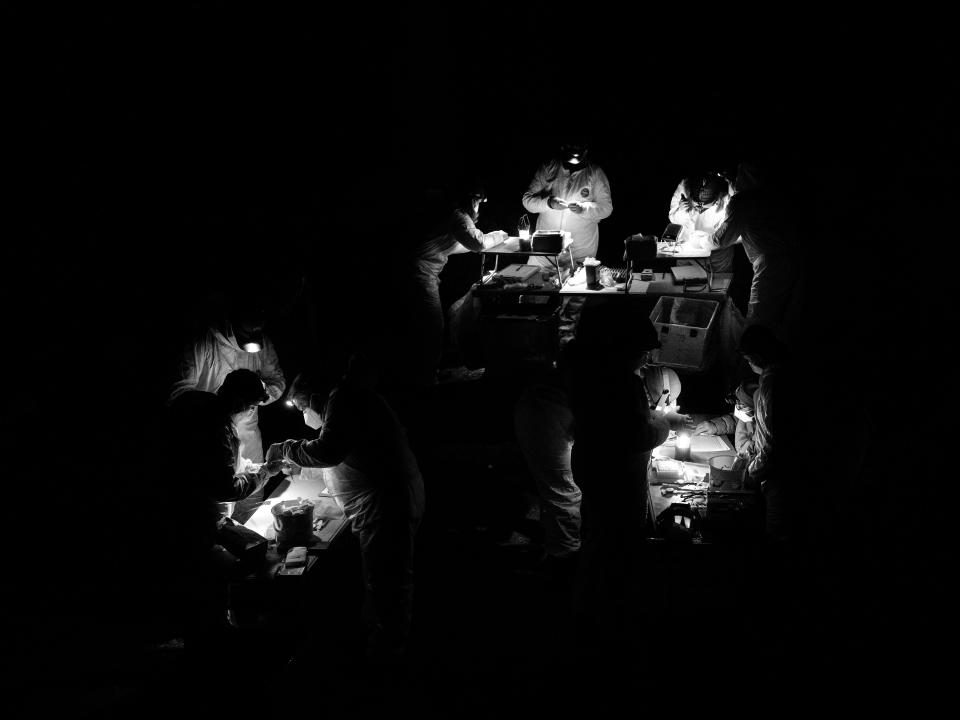Slaying the vampire that is killing bats
MINNETONKA CAVE, Idaho - It attacks in the dark. Like a vampire, it stalks its victims while they slumber, invading their flesh until they can take no more - and drop dead.
A deadly fungus has been menacing hibernating bats across North America, slaughtering the flying mammals by the millions.
On a recent crisp fall evening, under a full moon, about a dozen scientists at the mouth of this massive limestone cave deployed the scientific equivalent of a wooden stake: a first-of-its-kind bat vaccine.
One by one, researchers decked out in masks and white Tyvek jumpsuits trudged up from the cave with brown paper bags filled with bats clawing and squeaking for release. At a row of tables set up in the southeastern Idaho wilderness, Rita Dixon from the Idaho Department of Fish and Game gently stretched out one bat's translucent wing under headlamps to swab for the invisible killer.
She passed off the bat to her colleague, Tonie Rocke, a U.S. Geological Survey epidemiologist, for the most important step: dribbling a pipette of fluid down its mouth to deliver the potentially lifesaving vaccine.
One down. Tonight, said Rocke, "I'd like to get up around 150." Across the country, there are millions more to go.
Some point to bats as the origin of the virus behind covid-19. Now a coalition of federal and state agencies are marshaling some of the same technology used to develop coronavirus vaccines in their fight against bats' own deadly disease outbreak.
The research is cutting-edge but raises a question: It's difficult enough to vaccinate people.
How on earth do you vaccinate bats living deep in caves - or, for that matter, stop any disease outbreak in wild animals?
It's a quandary with no easy answers, but one we increasingly face. Global travel is allowing once-isolated diseases to leap continents at an expanding rate. Humans learned that the hard way with covid, but many animals are silently undergoing their own epidemics as wildlife pathogens hitch a ride on planes and ships.
Birds dying of avian flu. Starfish melting into goo. Frogs succumbing to heart-attack-inducing infections. Wildlife diseases are costing farms and governments a fortune, and exacerbating a worldwide extinction crisis that threatens to drive a million species to oblivion.
For a dozen species of bats in North America, the deadly disease is called white-nose syndrome. For some of them, it's an extinction-level threat, with researchers racing to respond with an everything-and-the-kitchen-sink approach. Without the night-flying predators to eat insects, farmers would lose a valuable source of pest control and ecosystems would be upended.
In Idaho, that means working in the dead of night to capture bats and test the vaccine, with the aim of conjuring up a way of someday inoculating bats more easily.
"We have to find a way that we can do it hands-off," Rocke said.
- - -
Creatures of the night
The menace emerged nearly 2,000 miles away in Upstate New York. Researchers there found a cave in 2007 littered with bat carcasses with noses that looked as though they had been dunked in white powder, as if the flying mammals had snorted cocaine.
The tiny mammals have mighty immune systems, allowing them to harbor many pathogens without getting sick. But testing at the National Wildlife Health Center, the USGS lab where Rocke works, revealed a culprit no one had ever seen.
The cold-loving fungus attacks bats when they are most vulnerable: during their long winter naps. As the animals huddle to hibernate, the disease jumps from bat to bat. The pathogen probably came from Europe or Asia, perhaps ferried across the Atlantic on a spelunker's shoe. Bats abroad seem to have built immunity, scientists say, but their North American brethren have little defense.
Despite the name, white-nose syndrome infects more than just bats' noses. Eating through their ears and wings, the fungus wakes the hibernators early, causing the bats to burn through valuable fat stores and their immune systems to go haywire. Before long, they succumb to dehydration and starvation.
The fungus is "highly specialized to invade at their weakest time of the year," said Jonathan Reichard, national assistant coordinator for white-nose syndrome at the U.S. Fish and Wildlife Service.
In a little more than a decade, the disease swept through at least 40 states from Maine to Washington, by one estimate killing more than 5 million bats in North America. At least three species have declined by more than 90 percent.
"It was alarming," Reichard said. At first, "my impression was all the bats were dying, every single last one of them, that we were going to see the end of hibernating bats in very short order. Obviously, that didn't happen. But in those first years, it was just a lot of shock."
- - -
The menace arrives
As soon as the disease was discovered, Dixon worried about Minnetonka Cave. More than 40,000 people come in the warmer months to gawk at the limestone pillars and dripping stalactites formed over eons.
But in the winter, bats rule the roost. The cave is closed to visitors as hundreds of bats of at least seven different species cling to its ceiling to shelter from the cold.
"This is the site we predicted would be our first detection" in Idaho, Dixon said. Officials set up a boot-washing station at the front of the cave. The pathogen could hitch a ride on someone's shoes, clothes or gear - or simply be flown in by a bat.
Dixon talked to Rocke, who was already working on a vaccine, about testing it here. Harboring a diverse array of bats, the Idaho cave was perfect for running trials. "Minnetonka Cave is a special place," Rocke said.
In 2022, they got the bad news: The fungus was here.
For now, bats at Minnetonka appear healthy. With the fungus just emerging, the cave was all the more suitable for testing the vaccine.
"That's good, that's good," the Idaho Department of Fish and Game's David Dressel said as the team rolled down a vertical array of wires at a door at the front of the cave. "Now we can tighten this back up," his colleague Jason Beck said as he strummed the strings.
This is a harp trap, designed to capture bats without hurting or entangling them. When bats flying out of the cave hit the wires, they plop into a basket for scientists to collect and vaccinate.
- - -
An animal vaccine drive
Rocke has spent most of her career thinking about how to vaccinate wild animals. Based in Madison, Wis., she is a nearly four-decade veteran at the National Wildlife Health Center, the main federal lab dedicated to studying wildlife disease.
It isn't easy. The usual way of inoculating people against covid and other diseases - a shot in the arm - is often a no-go in the animal kingdom. "We can't rely on capturing animals and injecting them," she said. "It's just too hard on the animals. And the people, quite honestly."
So Rocke's team has to get creative. "At the same time we're developing vaccines," she said, "we try and develop the methods for delivery."
For example, to save the black-footed ferret, that method was peanut butter. After an outbreak of plague struck North America's only native ferret species, Rocke and her team embedded their plague vaccine in peanut-butter-flavored bait for prairie dogs, the ferret's main prey, from which the predators can catch the disease.
"They love them," Rocke said of the bait.
For honeybees, the U.S. government approved this year the first vaccine for any insect. The distribution method is the queen: Incorporated into the matriarch's food, a vaccine for a bacterial disease called foulbrood makes its way to the ovaries so her offspring have immunity.
For bats, Rocke's team turned to a technique similar to what Johnson & Johnson and other vaccine makers used for coronavirus shots, genetically engineering a virus to express fungal antigens and prompting the bats to mount an immune response to the fungus.
Now Rocke wants to use bats' tendency to congregate - the reason white-nose syndrome is spreading - to fight the disease. Her team is considering putting their vaccine in a spray or paste that bats would bring back to their colonies. The goal is to "take advantage of their natural tendency to groom not only themselves but each other to administer the vaccine," Rocke said.
- - -
'Oh, my God! Oh, look at your ears!'
But first, the team needs to test whether the vaccine works. So at Minnetonka Cave, members are using the oral doses to ensure the bats get their medicine. This is one of 14 vaccine sites in Idaho, Texas, Washington state, Wisconsin and Wyoming where Rocke is running trials.
One by one, the team at Minnetonka plucked the tiny bats from the trap and put them into bags.
"Oh, my God! Oh, look at your ears!" U.S. Fish and Wildlife Service biologist Randi Connell cooed over a tiny bat that flashed its fangs after being taken out of a bag.
"It's really cute," Rocke said. It's a long-eared myotis, one of the rarer bat species this cave has to offer. "You don't see these very often."
But many of the bats at Minnetonka proved too clever for the trap, instead squeezing their way through tiny, high crevices to escape the cave for their nightly feeding.
Plan B: Guided through the dark only by headlamps, scientists scaled the wet cave walls to pluck the writhing bats unable to squirm away fast enough from the Tyvek-clad giants. The researchers remained unfazed by the incessant thrumming of bats flying overhead.
"The people that are inherently afraid of them, it's because they don't know enough about them," Mike Larsen, a U.S. Forest Service biologist, said right before climbing a wall and filling another paper bag.
"The movies make out this big old bloodsucking vampire bat," he added, "and it's just not the case."
Doling out a vaccine one by one clearly can't work at a massive scale, prompting Rocke to look at the other delivery methods. In Idaho, it took a team of about a dozen until about midnight to vaccinate about 150 bats for the trial by mouth, half getting the vaccine and the others getting a placebo.
Even with an improved method of administrating the vaccine, getting it into wild bats is a herculean task. "We might not get rid of the disease itself, but we want to build a resiliency so that they continue to have successful reproduction each year," said Abby Tobin, a bat biologist with the Washington Department of Fish and Wildlife working with Rocke.
"They're such slow-reproducing animals, so just losing one summer of reproduction, it can be detrimental."
- - -
'It's not going to be a single thing'
Vaccination is just one tool bat scientists are considering. Others are bathing bat roosts in ultraviolet light, applying chemicals that inhibit the fungus from growing, spraying a clay powder to grow beneficial bacteria on the bats' skin, and opening up underground vents to cool habitats and slow fungal growth.
"It's not going to be a single thing. It's probably not going to be one solution fits all," said Winifred Frick, chief scientist at the nonprofit Bat Conservation International. Her own remedy: Fattening up bats before winter by placing lights near caves to attract insects and create "bug buffets" so they can better survive infection during hibernation.
"They may not look as impressively fat as a bear, but they can definitely put on the pudge," she said.
There's an even bigger hurdle: conjuring up support for an animal many find icky.
After officials listed one species called the northern long-eared bat as endangered because of white-nose syndrome, Congress voted to claw back the decision over concerns about possible requirements to preserve forest habitat.
"I see the bald eagle. That makes sense. I see the bears. That makes sense. But long-eared bats? I hope the white-nose syndrome wipes all of them out. We won't have it to worry about," Rep. Ralph Norman (R-S.C.) said during a hearing this year.
President Biden ultimately vetoed the measure, keeping protections in place.
As for Rocke's vaccine work, "it took a little while before we convinced people to let us try it and we got the funding," she said.
- - -
Good night, bat
As the moon rose high and the clock ticked to midnight, Rocke dropped the serum into her last creature of the night. "I'm ready to get the Tyvek off."
As others disinfected the tables and other equipment, she trudged back into the cave for one last task. Opening up her laptop in the pitch black, she checked on the radio frequency identification system used to track the bats.
A coil of cable snaking around the door into the cave would sense every time a tagged bat flew through. The bars on the door were wide enough to allow bats through but narrow enough to keep humans out during the offseason.
Rocke heaved a stone in place to prevent two of the wire sensors from touching each other and ruining the experiment. "This is what we do," she said. "We MacGyver everything."
By tracking how many of the vaccinated and unvaccinated bats survive the winter and fly out in the spring, Rocke will see how effective the inoculations are.
Like the bats themselves, she will bide her time. "We won't know anything until next spring when bats emerge again," she said.
- - -
This article is part of Animalia, a column exploring the strange and fascinating world of animals and the ways in which we appreciate, imperil and depend on them.
Related Content
Trump Jr. testifies, deflects responsibility in N.Y. business-fraud case
From bullet holes to bloodstains: Documenting a synagogue mass killing
Matthew Perry, the one who mastered sarcasm with humor and pain










